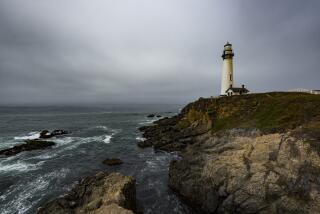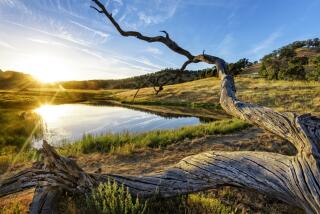The Denali Debate: Could Park Choke on Its Own Popularity? : Alaska: Mt. McKinley, the continent’s tallest peak, is central to question of affording greater access to visitors. Preservationists have voiced vigorous objections to development.
DENALI NATIONAL PARK, Alaska — On clear days, North America’s tallest peak fills the sky, towering over the tundra and reflecting in the waters of Wonder Lake to present one of Alaska’s most spectacular and often-photographed vistas.
But this is not a clear day. Campers huddled at a picnic shelter by the little lake dodge pouring rain, swat at mosquitoes and ponder their reasons for venturing into one of the wildest U.S. national parks.
“It’s just part of the big adventure, a photograph of the big mountain,” said Todd Harless, a newspaper photographer from West Virginia who has been waiting for the weather to clear around 20,320-foot Mt. McKinley.
“You think of your lifetime dreams. I’ve been ticking them off, one by one,” said Barbara Dix, an artist from Florida.
Mt. McKinley--known to Alaskans and mountaineers as Denali, an Athabascan Indian name meaning “The High One”--is Alaska’s most powerful magnet and the dominant feature of 6-million-acre Denali National Park and Preserve, which marks its 75th anniversary this year.
Human comfort is not an overriding priority. Grizzly bears, caribou, moose, wolves and other wild animals rule the terrain, at least for now.
Still, the number of visitors to the park grew to 558,870 in 1991 from 216,341 in 1980 and continues to boom.
Its popularity has hatched development schemes, many aimed at making views of the mighty mountain more accessible. But environmentalists fear that development will ruin the wilderness.
“If you look at the controversies that swirl around Denali, you can break most of them down to preservation versus use,” said park superintendent Russ Berry. “You get a sense that how goes Denali, how goes the state.”
Three times the size of Yellowstone National Park, Denali is one of the world’s last areas to need no human interference to maintain a balance of wild predators and prey.
Most visitors gain access by the park’s sole road, 92 miles mostly of gravel, traveling on packed shuttle buses operated by the Park Service and a concessionaire. Bus riders must have reservations and hikers and campers need permits to venture onto the trackless tundra.
There is little chance the Park Service will add to the more than 2,000 bus trips offered each summer. The risk is damage to wildlife and to visitors’ experiences, Berry said.
“Two buses looking at a grizzly bear is OK. How about five buses? When do you feel like you’re on a subway in New York City and not in a wilderness?” he said.
Tourists tend to endorse the restrictions, saying calls for more road access are foolish.
“OK, why don’t we pave a little more, further in and further in, all the way to Wonder Lake? And then you make a few more roads. Pretty soon you’ll get like Yellowstone,” said one shuttle bus rider, Alfred Thom of Honolulu, as he gazed over multihued Polychrome Pass.
But that is exactly what many Alaska officials have advocated for years.
The latest plan, boosted by the pro-devlopment administration of Gov. Walter Hickel, is to bulldoze a road along a route once used by dog sleds. The route, state officials claim, is a state right-of-way.
Alaska’s Republican U.S. Sen. Frank Murkowski advocates a high-speed monorail to zip visitors through the park.
The most likely development plan, however, is advanced by the Park Service itself. It would put new trails, visitor centers and cabins on the park’s often-neglected side pressed against the south slope of the Alaska range.
The south side is lusher and warmer and offers spectacular views of McKinley often ignored by tourists driving to the park’s entrance. It abuts Denali State Park, a 342,240-acre reserve rich with bears and close-up views of McKinley.
Southside Denali development schemes have been floated for decades. One, promoted by then-U.S. Sen. Mike Gravel in the 1970s, proposed a huge domed city and ski resort.
With those grandiose plans in mind, area residents have greeted the Park Service proposals with skepticism.
Talkeetna, a town of 400 best known as the launch site for McKinley climbing expeditions, produced a petition with 890 signatures protesting plans for a visitor center there.
But Mary Carey, an 80-year-old author, homesteader and proprietor of McKinley View Lodge, a rustic inn bordering the state park with spectacular views of the peak, says “progress” is inevitable.
“I don’t think anybody owns this mountain or this view of the mountain,” she said. “Everybody should have that opportunity. It’s fabulous.”
More to Read
Sign up for Essential California
The most important California stories and recommendations in your inbox every morning.
You may occasionally receive promotional content from the Los Angeles Times.










